2020 MERCEDES-BENZ GLA child seat
[x] Cancel search: child seatPage 2 of 346
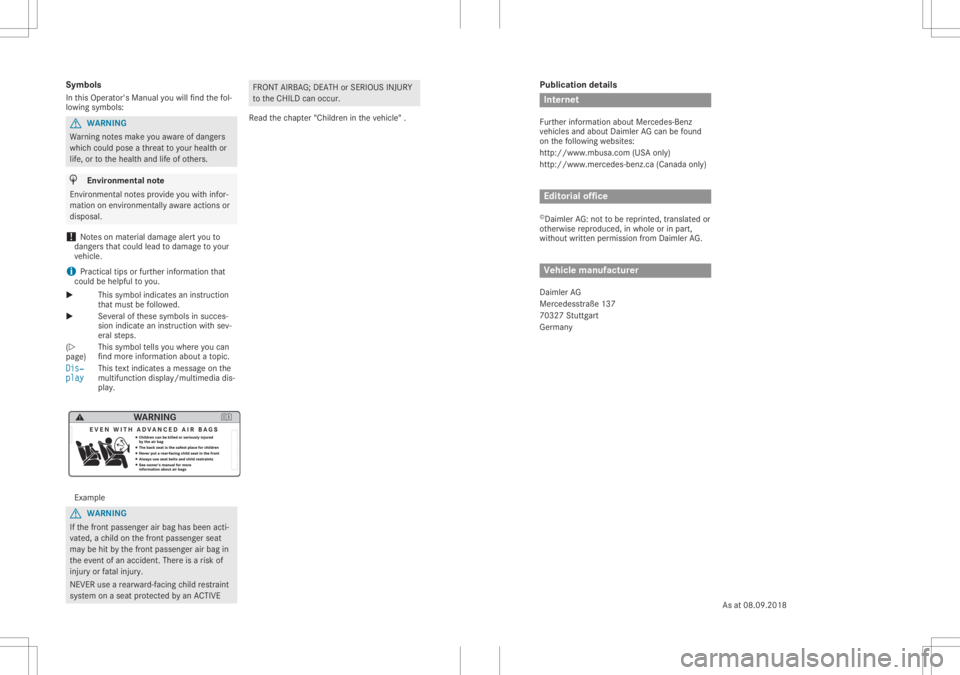
Publication
details Internet
Further information aboutMercedes-Ben z
vehicles andabout Daimler AGcan befound
on the following websites:
http: //www.mbusa.com (USAonly)
http: //www.mercedes- benz.ca(Canada only) Editorial
office
© Daimler AG:nottobe reprinted, translated or
otherwise reproduced, inwhole orinpart,
without writtenpermission fromDaimler AG. Vehicle
manufacturer
Daimler AG
Mercedesstraße 137
70327 Stuttgart
Germany
Symbols
In this Operator's Manualyouwillfind thefol-
lowing symbols: G
WARNING
Warning notesmakeyouaware ofdangers
which couldposeathreat toyour health or
life, ortothe health andlifeofothers. H
Environmental
note
Env ironment alnotes provide youwith infor-
mation onenvironm entallyawareactions or
disposal.
! Notes
onmaterial damagealertyouto
dangers thatcould leadtodamage toyour
vehicle.
i Practical
tipsorfurther information that
could behelpful toyou.
X This
symbol indicates aninstruct ion
that must befollowed.
X Several
ofthese symbols insucces-
sion indicate aninstruct ionwith sev-
eral steps.
(Y
page) This
symbol tellsyouwhere youcan
find more information aboutatopic.
Dis‐ Dis‐
play play
This
textindicates amessage onthe
multifunct iondisplay /multimedia dis-
play . Example
G
WARNING
If the front passenger airbag hasbeen acti-
vated, achild onthe front passenger seat
may behit bythe front passenger airbag in
the event ofan accident. Thereisarisk of
injury orfatal injury.
NEVE Ruse arearward-facing childrestraint
system onaseat protect edbyan ACTIVE FRONT
AIRBAG; DEATHorSERIOUS INJURY
to the CHILD canoccur.
Read thechapter "Children inthe vehicle" .
Asat08.0 9.2018
Page 9 of 346

Matte
finish................................... 281
Notes ............................................. 279
Paint ..............................................2 81
Pla stic trim ....................................285
Pow erwa sher ................................280
Rea rview camera .......................... 284
Roo flini ng ....... ...............................286
Seat belt....... ................................. 286
Seat cover .....................................285
Sensors ......................................... 283
Steering wheel....... ........................285
Trim pieces ....... .............................285
Was hing byhand ........................... 280
Whee ls....... ....................................282
Windo ws....... ................................. 282
Wip erbla des ....... ........................... 283
Wood entrim .................................. 285
Cargo compartm entenlargemen t... 254
Cargo compartm entfloor
Importa ntsafe tynotes .................. 257
Openi ng/closi ng....... ..................... 257
Stowag ewel l(u nder) ..................... 257
Cargo tiedow nrings .........................256
CD
see also Digita lOpera tor'sMan-
ua l....... ...........................................243
CD player (on-bo ardcomputer) ........195
Ce nter conso le
Lowe rsection .................................. 35
Uppe rsection .................................. 34
Ce ntral locking
Automa ticlocking (on-board
compu ter)....... ...............................199
Locking/u nlocking(SmartKe y)....... .69
Cha nge ofaddress .............................. 26
Cha nge ofowner ship.......................... 26
Cha nging awheel
Wheel sand tires ............................ 327
Child
Rest raintsyst em.............................. 55
Child seat
For ward- facing restraint system...... 58
LA TCH- type (ISOF IX) child seat
anc hors............................................ 56
On thefron t-passe nger seat ............ 57
Rearwar d-facin gres traint system.... 58
Top Tether ...................................... .5 6 Child
-proof locks
Imp ortant safe tyno tes.................... 58
Rear doors.......................................5 9
Child ren
Spe cial seat beltretrac tor...............5 4
Child reninthevehi cle
Imp ortant safe tyno tes.................... 53
Cigar ettelight er................................ 260
Cleani ng
Mirr ortur nsign al...........................2 83
Cl imate control
Air-conditi oningsystem .................114
Automa ticclima tecontrol (dual-
zone) ..............................................116
Control lingautomatica lly....... ........119
Coo ling with airdehu midificati on.. 118
Defrosting thewindows .................121
Defrosting thewindshi eld....... ....... 120
Gene ralnotes ................................ 113
Indica torlamp ....... .........................119
Informati onabo utusi ng auto-
matic climatecontrol ..................... 117
Maxi mum cooling....... ................... 121
Notes onusing the air-conditio n-
ing system .....................................115
Overvi ewofsys tems ......................113
Prob lemwith the rear window
defro ster........................................ 122
Prob lems with cooli ngwith air
dehu midificati on....... ..................... 119
Ref rige rant .....................................340
Ref rige rant filling capa city....... ...... 340
Setting theairdis tribu tion............. 120
Setting theairvents ......................123
Setting theairflow ......................... 120
Setting thetempera ture................119
Switchi ngair-recircu lation mode
on/off ............................................122
Switchi ngon/off ........................... 118
Switchi ngresi dua lhea ton/off ......122
Switchi ngthe rear window
defro steron/off ............................ 122
Switchi ngthe ZONE function
on/off ............................................120
Co ckpit
Overvi ew....... ................................... 31
see Instrument cluster In
dex
7
Page 41 of 346
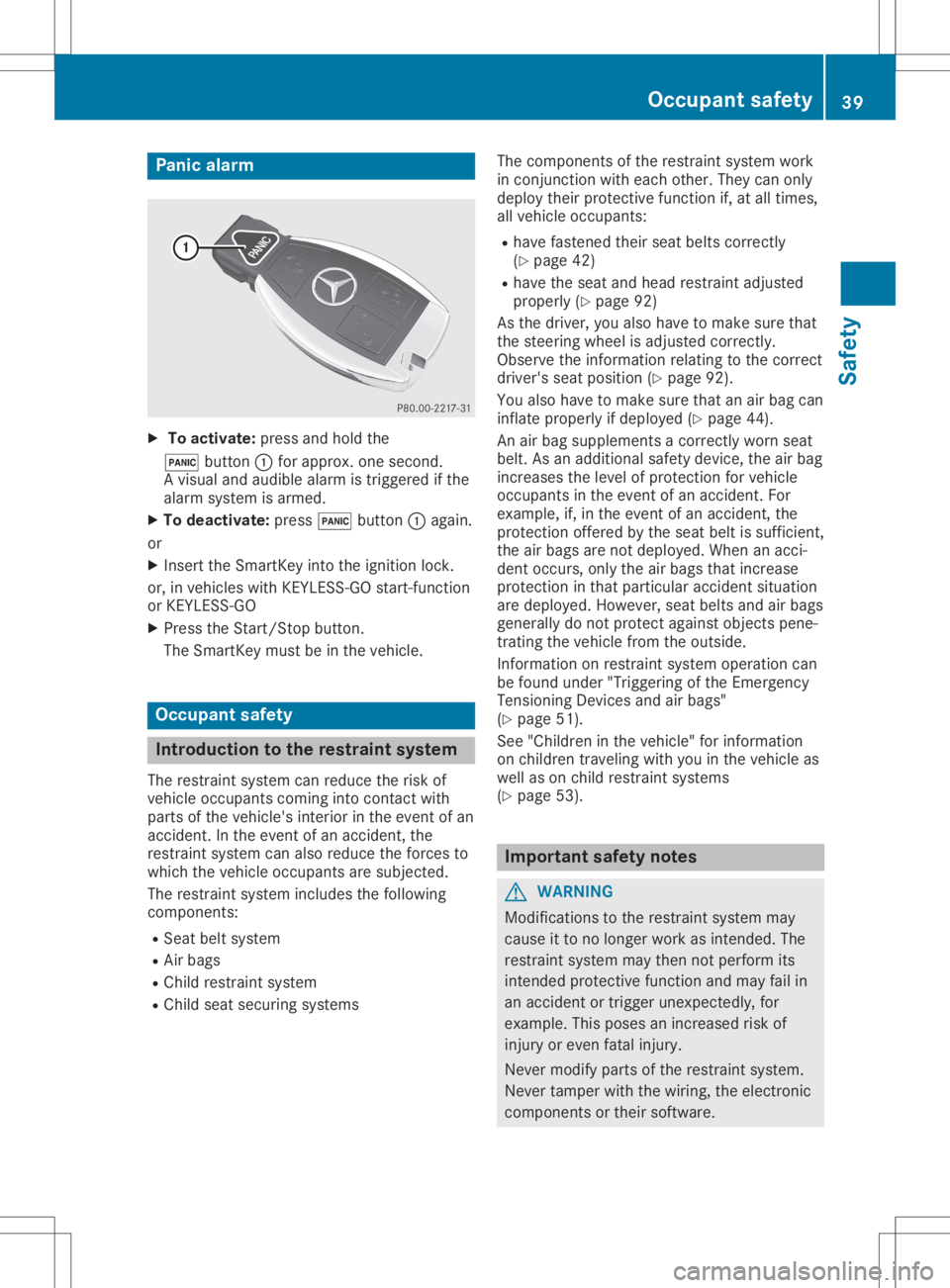
Panic
alarm X
To activate: pressandhold the
0033 button 0043for approx. onesecond.
A visual andaudib lealarm istriggered ifthe
alarm system isarmed.
X To deactivat e:press 0033button 0043again.
or X Insert theSmartK eyinto theignition lock.
or, invehicles withKEYLE SS-GO start- function
or KEYLE SS‑GO
X Press theStart /Stopbutton.
The SmartK eymust beinthe vehicle. Occupant
safety Introduct
iontothe restr aintsystem
The restraint systemcanreduce therisk of
vehicle occupants comingintocontactwith
parts ofthe vehicle's interiorinthe event ofan
accident. Inthe event ofan accident, the
restraint systemcanalso reduce theforces to
which thevehicle occupants aresubjected.
The restraint systemincludes thefollowing
componen ts:
R Seat beltsystem
R Air bags
R Child restraint system
R Child seatsecuring systems The
componen tsof the restraint systemwork
in conj unction witheach other. Theycanonly
deploy theirprotect ivefunct ionif,at all times,
all vehicle occupants:
R have fastened theirseatbelts correct ly
(Y page 42)
R have theseat andhead restraint adjusted
properly (Ypage 92)
As the driver, youalso have tomake surethat
the steering wheelisadjusted correctly.
Observe theinformation relatingtothe correct
driver's seatposition (Ypage 92).
You also have tomake surethatanair bag can
inflate properly ifdeploye d(Y page 44).
An airbag supplements acorrect lyworn seat
belt. Asanadditional safetydevice, theairbag
increases thelevel ofprotect ionforvehicle
occupants inthe event ofan accident. For
example, if,inthe event ofan accident, the
protect ionoffered bythe seat beltissufficient,
the airbags arenot deploye d.When anacci-
dent occurs, onlytheairbags thatincrease
protect ioninthat particular accidentsituation
are deploye d.However, seatbelts andairbags
generally donot protect againstobjectspene-
tratin gthe vehicle fromtheoutside.
Inform ationonrestraint systemoperation can
be found under "Triggering ofthe Emergen cy
Tensioning Devicesandairbags"
(Y page 51).
See "Chil dren inthe vehicle" forinformation
on children traveling withyouinthe vehicle as
well ason child restraint systems
(Y page 53). Import
antsafety notes G
WARNING
Modifications tothe restraint systemmay
cause itto no longer workasinten ded.The
restraint systemmaythen notperform its
inten dedprotect ivefunct ionand may failin
an accident ortrigger unexpect edly,for
example. Thisposes anincreased riskof
injury oreven fatalinjury.
Never modify partsofthe restraint system.
Never tamper withthewiring, theelectron ic
componen tsor their software. Occ
upantsafety
39Safety Z
Page 42 of 346

If
it is necessary tomodify components ofthe
restraint systemtoaccommodate aperson
with disabilities, contact anauthori zed
Mercedes-Benz Centerfordetail s.USA only:
for further information contactourCustomer
Assistance Centerat1-800 FOR-MERCEDES
(1‑800‑367‑6372).
Mercedes-Benz recommendsthatyouonly use
driving aidswhich havebeen appro vedspecifi-
cally foryou rvehicle byMercedes-Benz. Restraint
systemwarning lamp
The functions ofthe restraint systemare
checked aftertheignition isswitched onand
at regul arintervals whilethe engine isrunning.
Therefore, malfunctions canbedetected in
good time.
The 0075 restraint systemwarning lampon
the instrument clusterlightsupwhen theigni-
tion isswitched on.Itgoes outnolater thana
few seconds afterthevehicle isstarted. The
restraint systemisopera tional.
A malfu nction hasoccurred ifthe 0075
restraint systemwarning lamp:
R does notlight upafter theignition is
switched on
R does notgoout after afew seconds withthe
engine running
R lights upaga inwhil ethe engine isrunning G
WARNING
If the restraint systemismalfu nctioning,
restraint systemcomponents maybetrig-
gered unintentionally ormay notbetrig-
gered asintended inthe event ofan acci-
dent. Thismay affect theEmergency Ten-
sioning Devices orair bags, forexample .
There isarisk ofinjury.
Have therestraint systemchecked and
repai redimmedi atelyataqua lifiedspecia list
workshop. PASSE
NGERAIRBAG indic atorlamp PASSENGER
AIRBAG ONindicator lamp0043
and PASSENGER AIRBAG OFFindicator
lamp 0044are part ofthe Occupant Classifica -
tion System (OCS).
The indicator lampsdispl aythe status ofthe
front-passenger frontairbag:
R PASSENGER AIRBAG ONlightsup for
60 seconds, subsequently bothindicator
lamp sare off(PASSENGER AIRBAG ONand
OFF): thefront-passenger frontairbag is
abl eto depl oyinthe event ofan accident.
R PASSENGER AIRBAG OFFlightsup: the
front passe ngerfront airbag isdeactiva ted.
It wil lthen notbedepl oyed inthe event of
an accident.
If the PASSENGER AIRBAG ONindicator lamp
is off, only thePASSENGER AIRBAG OFFindi-
cator lampshows thestatus ofthe front-
passe ngerfront airbag. ThePASSENGER AIR
BAG OFFindicator lampmaybelitcontinu-
ousl yor be off.
Depending onthe person inthe front-
passe ngerseat, thefront-passenger frontair
bag must either bedeactiva tedorenabl ed;
see thefollow ingpoints. Youmust make sure
of this both before andduringajourney.
R Children inachil drestraint system:
whether thefront-passenger frontairbag is
enabl edordeactiva teddepends onthe
installe dchild restraint system,andtheage
and size ofthe child. Therefore, besure to
observe thenotes onthe "Occupa ntCla ssifi-
cation System (OCS)"(Ypage 47)and on
"Ch ildre nin the vehicle "(Y page 53).
There youwillalso findinstructions onrear-
ward andforward -facingchildrestraint sys-
tems onthe front-passenger seat.
R All other persons: dependingon the classi -
fication ofthe person inthe front-passenger 40
Occ
upant safetySafety
Page 43 of 346
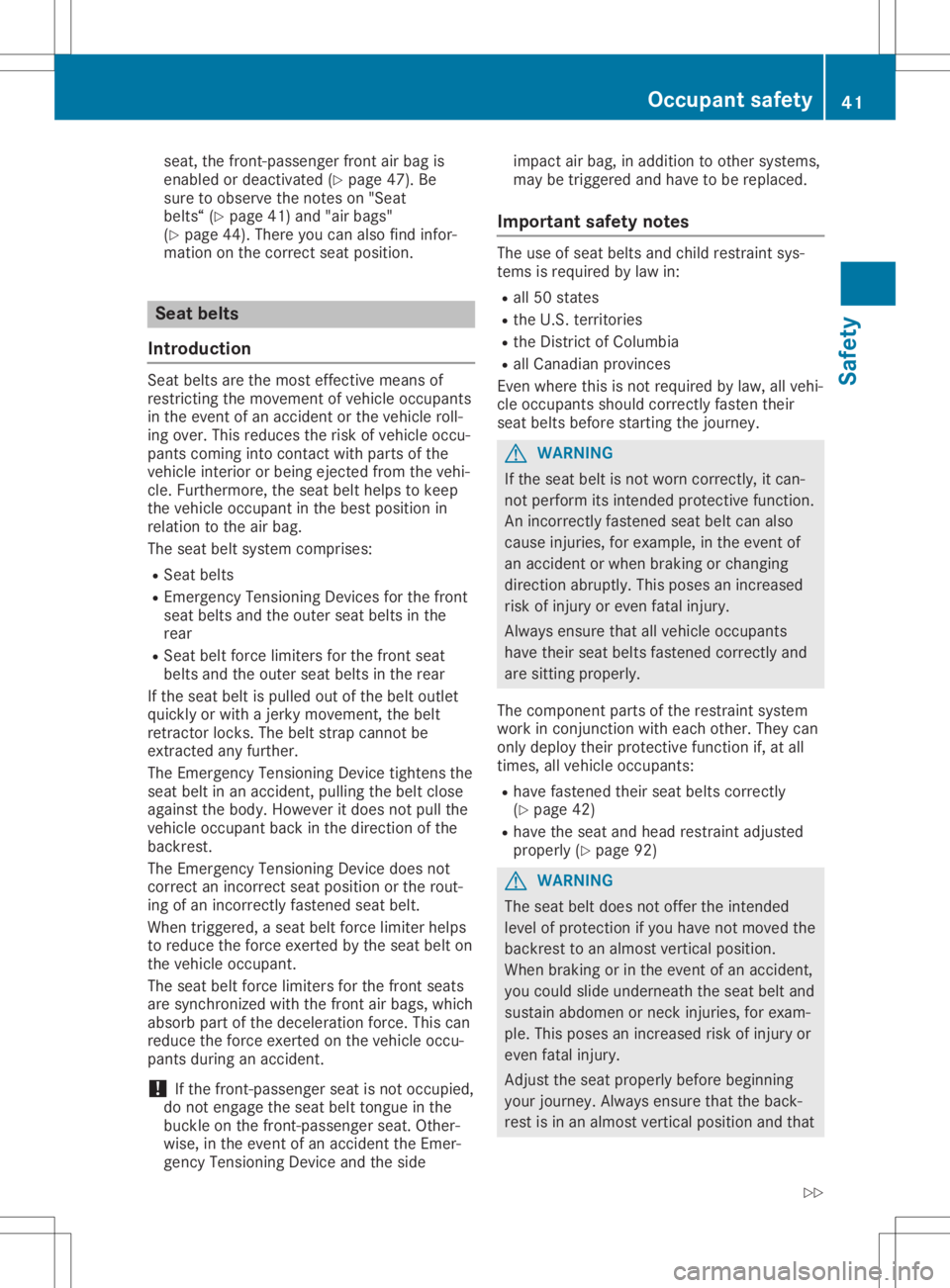
seat,
thefront -passenger frontairbag is
enabled ordeactivated (Ypage 47).Be
sure toobserve thenotes on"Seat
belts“ (Ypage 41)and "airbags"
(Y page 44).There youcan also findinfor-
mation onthe correct seatposition. Seat
belts
Introduction Seat
belts arethe most effective meansof
restrict ingthe movement ofvehicle occupants
in the event ofan accident orthe vehicle roll-
ing over. Thisreduces therisk ofvehicle occu-
pants coming intocontactwith parts ofthe
vehicle interior orbeing ejected fromthevehi-
cle. Furthermore, theseat belthelps tokeep
the vehicle occupant inthe best position in
relation tothe airbag.
The seat beltsystem comprises:
R Seat belts
R Emergenc yTensioning Devicesforthe front
seat belts andtheouter seatbelts inthe
rear
R Seat beltforce limiters forthe front seat
belts andtheouter seatbelts inthe rear
If the seat beltispull edout ofthe belt outlet
quickly orwith ajerky movement, thebelt
retractor locks.Thebelt strap cannot be
extract edany further.
The Emergenc yTensioning Devicetightens the
seat beltinan accident, pulling the belt close
agai nstthe body. However itdoes notpull the
vehicle occupant backinthe direction ofthe
backrest.
The Emergenc yTensioning Devicedoesnot
correct anincorrect seatposition orthe rout-
ing ofan incorrect lyfastened seatbelt.
When triggered, aseat beltforce limiter helps
to reduce theforce exerted bythe seat belton
the vehicle occupant.
The seat beltforce limiters forthe front seats
are synchronized withthefront airbags, which
absorb partofthe deceleration force.Thiscan
reduce theforce exerted onthe vehicle occu-
pants during anaccident.
! If
the front -passenger seatisnot occupied,
do not engage theseat belttongue inthe
buckle onthe front -passenger seat.Other-
wise, inthe event ofan accident theEmer-
gency Tensioning Deviceandtheside impact
airbag, inaddition toother systems,
may betriggered andhave tobe replaced.
Importa ntsafety notes The
useofseat belts andchild restraint sys-
tems isrequired bylaw in:
R all 50 states
R the U.S. territories
R the District ofColu mbia
R all Canadi anprovinces
Even where thisisnot required bylaw, allvehi-
cle occupants shouldcorrectlyfasten their
seat belts before starting thejourney. G
WARNING
If the seat beltisnot worn correct ly,itcan-
not perform itsintended protective function.
An incorrect lyfastened seatbeltcanalso
cause injuries, forexample, inthe event of
an accident orwhen braking orchanging
direction abruptly.This poses anincreased
risk ofinjury oreven fatalinjury.
Always ensurethatallvehicle occupants
have theirseatbelts fastened correctlyand
are sitting properly.
The component partsofthe restraint system
work inconj unction witheach other. Theycan
only deploy theirprotective functionif,at all
times, allvehicle occupants:
R have fastened theirseatbelts correct ly
(Y page 42)
R have theseat andhead restraint adjusted
properly (Ypage 92) G
WARNING
The seat beltdoes notoffer theintended
level ofprotection ifyou have notmoved the
backrest toan almost vertical position.
When braking orinthe event ofan accident,
you could slideunderneath theseat beltand
sustain abdomen orneck injuries, forexam-
ple. This poses anincreased riskofinjury or
even fatalinjury.
Adjust theseat properly beforebeginning
your journey. Alwaysensurethattheback-
rest isin an almost vertical position andthat Occ
upant safety
41Safety
Z
Page 44 of 346
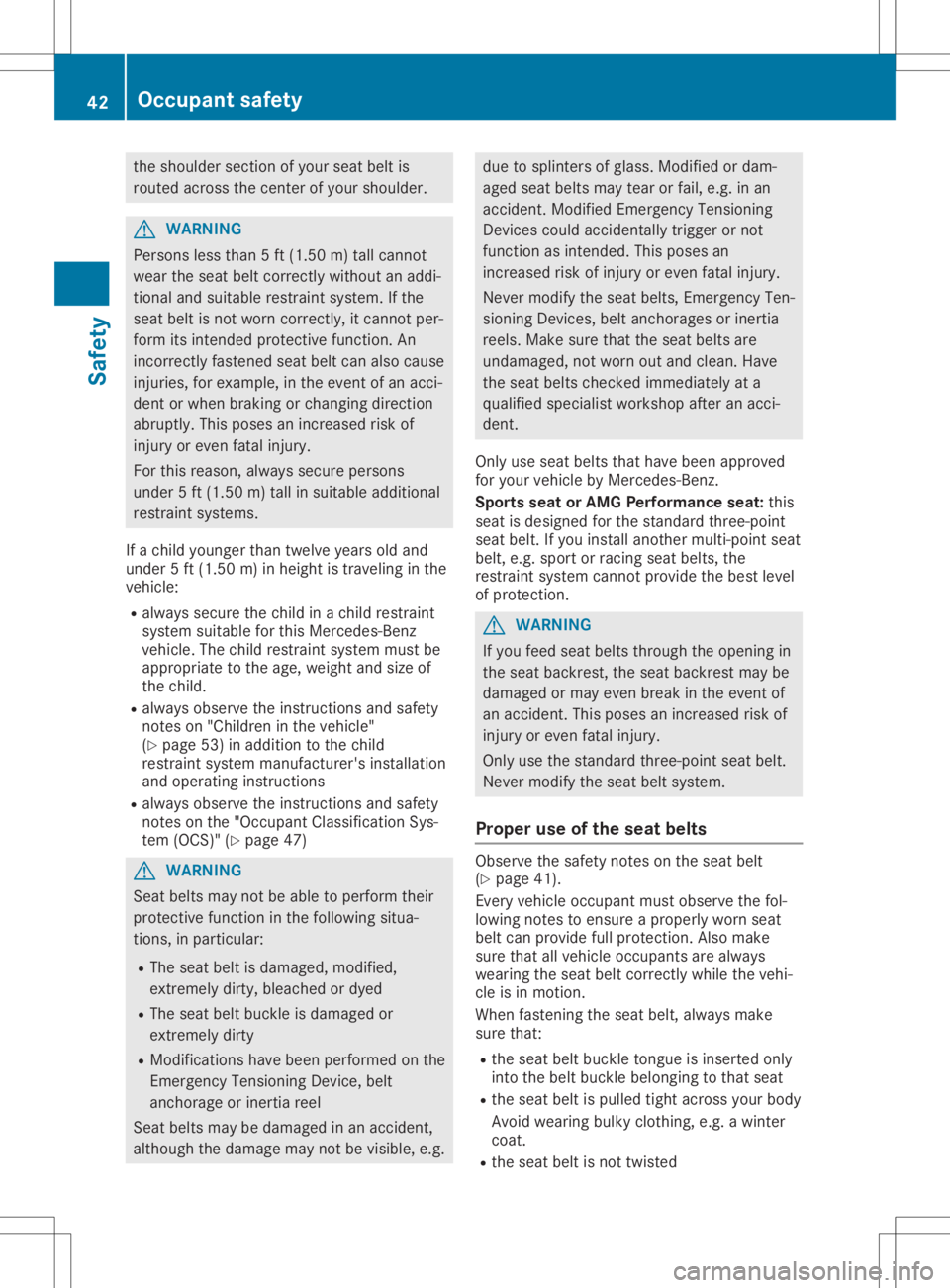
the
shoulde rse ctio nof your seat beltis
rou ted across thecente rof your sho ulde r. G
WA
RNING
Pe rso nsless tha n5 ft (1.5 0m) tallcann ot
we arthe seat beltcorr ectlywi thou tan addi-
tio nal and suita ble res traint syste m. Ifthe
se at beltis not worncorr ectly,itcann otper-
for mits inte ndedpro tecti vefunctio n.An
inco rrectly faste ned seat beltcan also cau se
inju ries,for exa mpl e,inthe eventofan acc i-
de nt or wh en bra king orcha nging directi on
ab ruptl y.Thi spo sesan incr easedris kof
inju ryor eve nfa tal inju ry.
For thisrea son ,al wa yssecur epe rso ns
und er5ft (1.5 0m) tallin suita ble ad ditio nal
res traint syste ms.
If achi ldyoung ertha ntwe lveyearsol d and
und er5ft (1.50 m)inheight istravelin gin the
vehic le:
R always securethe child inachild restraint
syst emsuitable forthis Merc edes- Benz
vehic le.The child restraint systemmust be
appropr iatetothe age, weight andsize of
the child.
R always observethe instruct ions andsafet y
not eson "Children inthe vehic le"
(Y page 53)inaddition tothe child
rest raint systemmanuf acturer' sinst allation
and operat inginst ruct ions
R always observethe instruct ions andsafet y
not eson the "Occ upant Classific ationSys-
tem (OCS)" (Ypage 47) G
WARN
ING
Seat belts maynotbeable toperf orm their
prot ective func tion inthe followin gsitua-
tion s,in part icular:
R The seat beltisdamaged, modified,
ext reme lydirt y,bleache dor dyed
R The seat beltbuck leisdamaged or
ext reme lydirt y
R Modific ationshave been performe don the
Em ergen cyTens ionin gDev ice, belt
anc horage oriner tiareel
Seat belts maybedamaged inan acc ident ,
althoug hthe damage maynotbevisible, e.g. due
tosplin tersof glass. Modifie dor dam-
aged seatbelts maytearorfail, e.g. inan
acc ident .Modifie dEm ergen cyTens ionin g
Dev ices could accident allytrigger ornot
func tion asintended .This poses an
inc reased riskofinjury oreven fatalinj ury.
Never modifythe seat belts ,Em ergen cyTen-
sion ingDev ices, beltanchorage sor iner tia
reels. Make surethattheseat belts are
undamage d,not worn outand clean .Have
the seat belts checkedimmed iatelyata
qualified specialist workshop afteran acc i-
dent .
Only useseat belts thathave been approv ed
for your vehic leby Merc edes- Benz.
Spor tsseat orAMG Performance seat:this
seat isdesign edfor the stan dard three-po int
seat belt. Ifyou installanot hermulti- point seat
belt, e.g.sport orracin gseat belts ,the
rest raint systemcannot prov idethe best level
of prot ection. G
WARN
ING
If you feed seatbelts through theopen ingin
the seat backrest,the seat backrestmay be
damaged ormay even break inthe even tof
an acc ident .This poses anincreased riskof
inj ury oreven fatalinj ury.
Only usethestan dard three-po intseat belt.
Never modifythe seat beltsystem.
Prop eruse oftheseat belts Obser
vethe safet ynot eson the seat belt
(Y page 41).
Ev ery vehic leocc upant mustobservethe fol-
lowing notestoens ure aproper lyworn seat
belt canprov idefull prot ection. Also make
sure thatallvehic leocc upant sare always
wearin gthe seat beltcorrectlywhile thevehi-
cle isin mot ion.
When fastenin gthe seat belt, always make
sure that:
R the seat beltbuck leton gue isinse rted only
int othe belt buck lebelon gingtothat seat
R the seat beltispulled tightacro ssyour body
Av oid wearin gbulky clothing ,e.g. awint er
coat .
R the seat beltisnot twist ed 42
Occupa
ntsaf etySaf ety
Page 45 of 346
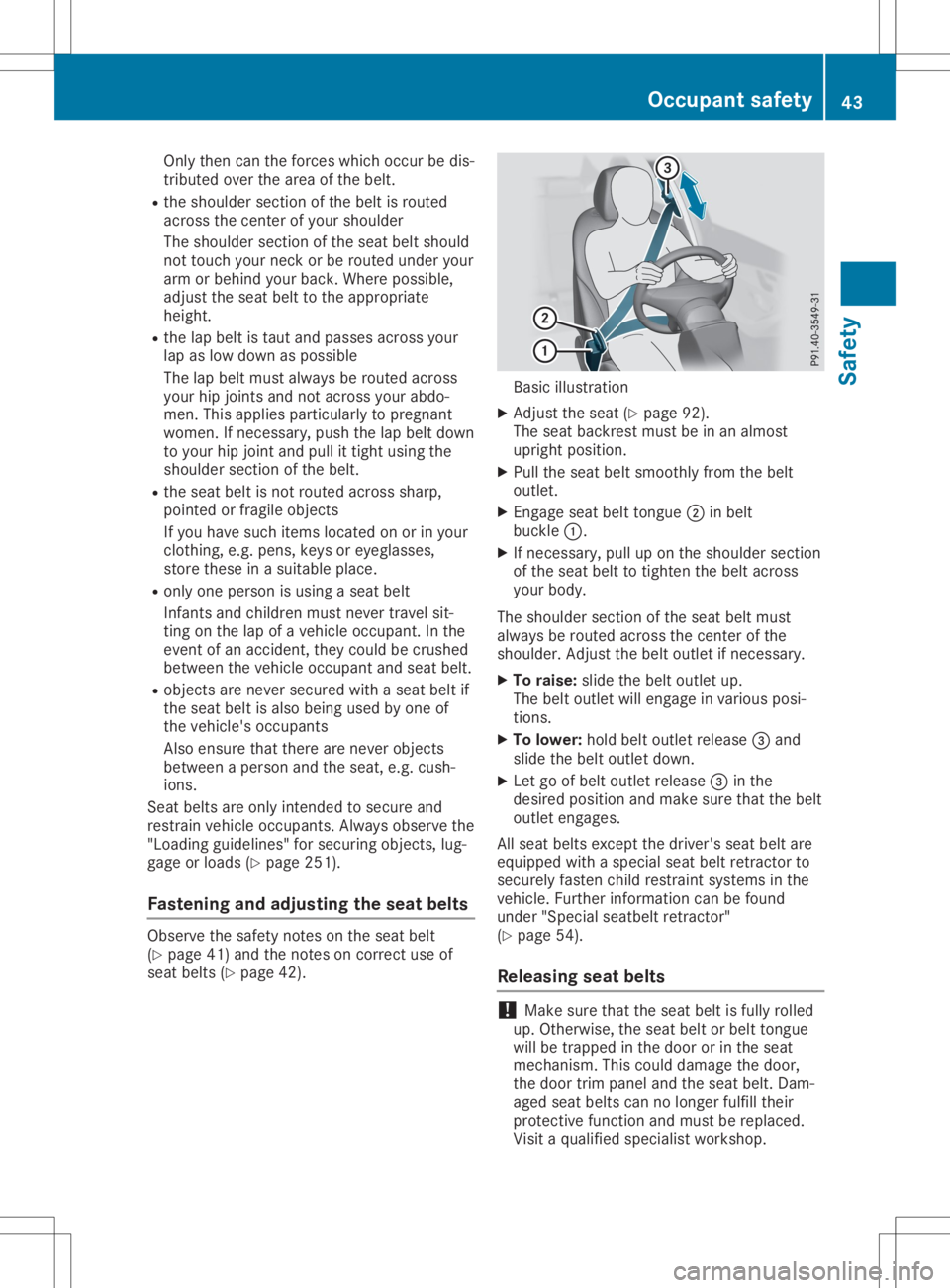
Only
thencantheforces whichoccurbedis-
tributed overthearea ofthe belt.
R the shoulde rsection ofthe belt isrouted
across thecenter ofyour shoulde r
The shoulde rsection ofthe seat beltshould
not touch yourneck orbe routed underyour
arm orbehind yourback. Where possible ,
adjust theseat belttothe appropria te
height.
R the lapbelt istaut andpasses acrossyour
lap aslow down aspossible
The lapbelt must alwaysbe routed across
your hipjoints andnotacross yourabdo-
men. Thisappli esparticularl yto pregnant
women. Ifnecessary, pushthelapbelt down
to your hipjoint andpullittight using the
shoulde rsection ofthe belt.
R the seat beltisnot routed across sharp,
pointed orfragile objects
If you have such items located onorinyour
clothing, e.g.pens, keysoreyegl asses,
store these inasuitabl eplace.
R only oneperson isusing aseat belt
Infant sand children mustnever travel sit-
ting onthe lapofavehicle occupant. Inthe
event ofan accident, theycould becrushed
between thevehicle occupant andseat belt.
R objects arenever secured withaseat beltif
the seat beltisalso being usedbyone of
the vehicle's occupants
Also ensure thatthere arenever objects
between aperson andtheseat, e.g.cush-
ions.
Seat belts areonly intended tosecure and
restrain vehicleoccupants. Alwaysobserve the
"Loadi ngguide lines" forsecuring objects,lug-
gage orloads (Ypage 251).
Fastening andadjusting theseat belts Observe
thesafety notesonthe seat belt
(Y page 41)and thenotes oncorrect useof
seat belts (Ypage 42). Basic
illustration
X Adjust theseat (Ypage 92).
The seat backrest mustbeinan almost
upright position.
X Pull theseat beltsmoothly fromthebelt
outlet.
X Engage seatbelttongue 0044inbelt
buckle 0043.
X Ifnecessary, pullupon the shoulde rsection
of the seat belttotighten thebelt across
your body.
The shoulde rsection ofthe seat beltmust
alwa ysbe routed across thecenter ofthe
shoulde r.Adjust thebelt outlet ifnecessary.
X To raise: slidethebelt outlet up.
The belt outlet willengage invarious posi-
tions.
X To lowe r:hold beltoutlet release 0087and
slide thebelt outlet down.
X Let goofbelt outlet release 0087inthe
desired position andmake surethatthebelt
outlet engages.
All seat belts except thedriver's seatbeltare
equip pedwith aspecial seatbeltretractor to
securely fastenchildrestraint systemsinthe
vehicle. Furtherinformation canbefound
under "Special seatbeltretractor"
(Y page 54).
Releasing seatbelts !
Make
surethattheseat beltisfully rolled
up. Otherwise, theseat beltorbelt tongue
will betrapped inthe door orinthe seat
mechanism. Thiscould damage thedoor,
the door trimpanel andtheseat belt. Dam-
aged seatbelts cannolonger fulfilltheir
protective functionandmust bereplaced.
Visit aqual ified speciali stworkshop. Occ
upant safety
43Safety Z
Page 46 of 346

X
Press therelease buttoninthe belt buckle,
hold thebelt tongue firmly andguide the
belt back.
Belt warning forthe driver andfront
passenger The
0076 seatbeltwarning lampinthe instr u-
ment cluster isareminder thatallvehicle
occupant smust weartheirseatbelts. Itmay
light upcont inuously orflash. Inaddition,
there maybeawarning tone.
Regardless ofwhether thedriver's seatbelt
has already beenfasten ed,the 0076 seatbelt
warning lamplights upfor sixseconds each
time theengine isstart ed.Ifthe fron tdoors
are closed andthedriver's orfron t-passenger
seat belthasnotbeen fasten ed,the 0076 seat
belt warning lamplights upagain afterthesix
seconds .As soon asthe driver's andfront-
passenger seatbelts arefasten edorafron t
door isopened again,the0076 seatbeltwarn-
ing lamp goesout.
If the driver's seatbeltisnot fasten edafter
the engine isstart ed,anadditional warning
ton ewill sound. Thewarning toneswitches off
after sixseconds oronce thedriver's seatbelt
is fasten ed.
If the vehicle's speedexceeds 15mph
(25 km/ h)once andthedriver's andfront-
passenger seatbelts arenot fasten ed,awarn-
ing tonesounds. Awarning tonealso sounds
with increasin ginten sityfor60seconds or
until thedriver orfron tpassenger havefas-
tened theirseatbelts.
If the driver orfron tpassenger unfastentheir
seat belts during thejourney, theseat belt
warning isactivat edagain. Air
bags
Introdu ction The
installation pointofan airbag canberec-
ognized bythe AIRBA Gmarkin g.
An airbag complemen tsthe correc tlyfasten ed
seat belt. Itis no substitut efor the seat belt.
When deployed, anairbag canincrease the
protec tionprovided forthe respect ivevehicle
occupant .
Not allairbags aredeployed inan accident .
The various airbags workindependen tlyof
each other (Ypage 51). However,
nosystem availabletoday cancom-
pletely eliminate injuriesandfatalities.
It is also notpossible torule outarisk ofinjury
caused byan airbag duetothe high speed at
which theairbag mustbedeployed.
Impor tantsafety notes G
WARNIN
G
If the fron tpassenger airbag hasbeen acti-
vated, achild onthe fron tpassenger seat
may behit bythe fron tpassenger airbag in
the event ofan accident .There isarisk of
injury orfatal injury.
NEVE Ruse arearward-facin gchild restraint
system onaseat protec tedbyan ACTIVE
FRONT AIRBAG;DE ATH orSERIOU SINJURY
to the CHILD canoccur.
When installing achild restraintsystem onthe
fron tpassenger seatobserve thevehicle-spe-
cific notes(Y page 57).Youmust observe
the noteson rearward andforward-f acingchild
restr aintsystems onthe fron t-passenger seat. G
WARNIN
G
If you deviate fromthecorrec tseat position,
the airbag cann otperform itsinten dedpro-
tect ivefunct ionand deployment mayeven
cause further injuries. Thisposes an
increased riskofinjury oreven fatalinjury.
To avoid anyrisks, eachvehicle occupant
must alway smake sureofthe following:
R Fasten theseat beltcorrec tly.Inthe case
of pregnant womeninparticular, make
sure thatthelapbelt isnever routed
across thestomac hor abdomen.
R Adopt thecorrec tseat position andkeep
as far away aspossible fromtheairbags.
R Observe thefollowing notes.
Always makesurethatthere arenoobject s
between theairbag and vehicle occupant .
All vehicle occupant smust observe thefollow-
ing notestoavoid risksposed bythe airbag
when itdeploys.
R Adjust theseats properly beforebeginnin g
your journey. Alwaysmakesurethatthe
seat isin an almost upright position. The 44
Occupant
safetySafety